Scientists at Warwick University have developed synthetic antifreeze proteins that mimic the natural ones.
Highlights:
- Formation of ice crystals at lower temperatures have been a constant hinderance to both clinical and industrial applications.
- These ice crystals cause damage to materials as simple as ice creams to complex organs used for transplantation.
- Researchers have developed a synthetic form of anti freeze proteins that are naturally produced by species living in freezing temperatures.
While ice has various advantages in day-to-day life, it is not favorable to have ice formation on airplane wings, turbines, ice cream and so on.
- Ice creams loose their creamy texture when stored for long in cold temperatures due to ice crystal formation.
- Ice crystal deposition on wind turbines lower the performance rate.
- Ice crystals are a major hinderance in frozen food processing.
- Ice crystal formation on airplane wings obstruct wind flow and may result in loss of control of airplanes.
- Human organs and tissues used for transplantation and other therapeutic purposes have a threat of ice crystal formation when stored for longer periods of time, which may result in cell death.
Antifreeze proteins are molecules that control ice formation and growth. They do not stop but slow the growth of ice crystals.Ice crystals have an unusual property called recrystallizing. When water freezes, many small crystals form, but some of these grow larger and larger in size. Anti freeze proteins bind to surfaces of the small crystals and minimize this recrystallization effect. Anti freeze proteins are also famous for their ability to lower the freezing point of water to prevent clotting of blood at sub zero temperatures.
However, naturally occurring antifreeze proteins are expensive and potentially immunogenic and toxic to the cells. This makes synthetic mimics appealing for clinical application. But due to lack of understanding the antifreeze protein mechanism, designing mimics is complicated.
Synthetic mimics of anti freeze proteins:
There are only a a handful of synthetic materials that can reproduce the ice recrystallization inhibition property of anti freeze proteins. The research team at Warwick University have identified metallohelices with ice recrystallization inhibition activity which may have potential applications in a wide variety of fields.
References:
- Mitchell, D. E., Clarkson, G., Fox, D. J., Vipond, R. A., Scott, P., & Gibson, M. I. (2017). Antifreeze Protein Mimetic Metallohelices with Potent Ice Recrystallization Inhibition Activity. Journal of the American Chemical Society, 139(29), 9835-9838. doi:10.1021/jacs.7b05822
- Antifreeze Proteins - (http://pdb101.rcsb.org/motm/120)















